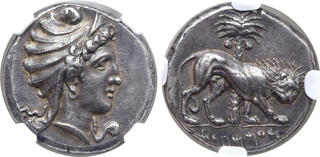Lot description:
Sicily, Siculo-Punic AR Tetradrachm. 'People of the Camp' mint (Entella?), circa 320-315 BC. Female head (Artemis-Tanit or Elissa-Dido?) to right, wearing Phrygian tiara / Lion walking to right; palm tree with three date clusters behind, s'mmhnt ('People of the Camp') in Punic in exergue. Jenkins, Punic, series 4, 272 (O85-R226, these dies); De Luynes 1472 (these dies); Rizzo pl. 68, 8 (these dies); Boston MFA 36 (these dies). 17.31g.
NGC graded AU★ 5/5 - 5/5 (#6674505-002). Extremely Rare.
Ex 'Exceptional Collection' assembled between the early 70's-late 90's, Numismatica Ars Classica, Auction 132, 30 May 2022, lot 233 (hammer: CHF 130,000).
Carthage, at the head of considerable commercial empire in the western Mediterranean, like Etruria and Phoenicia, did not adopt the Greek practice of coining until the last decade of the 5th century BC when she came into direct contact with the Greek city states of Sicily such as Naxos, Syracuse and Messana, which had started to produce coins of the highest technical quality in the artistic style of the late archaic Greek school in the last quarter of the 6th century BC.
The origin of the so-called Siculo-Punic coinage, often of rather crude style mostly imitating contemporary Syracusan tetradrachms produced at Rash Melkarth (= 'Promontory of Herakles', possibly Kephaloidion), Panormos (Ziz, 'the splendid'), Motya (the 'spinning factory') and the 'people of the camp' and 'pay master' military mint (generally considered that of Entella) for the payment of the army including many Italian and Greek mercenaries, is dated to about 410 BC and the Carthaginian military operations in Sicily. Hannibal, grandson of Hamilcar, taking the opportunity presented by the quarrels of the Greek cities in Sicily and of the mutual exhaustion of Athens and Syracuse, invaded western Sicily with a strong military force and defeated the Greeks at Himera in 409.
The obverse female figure is wearing an oriental tiara in the form of a Phrygian cap, which in Greek iconography generally denotes personages of oriental origin, including Amazons, Trojans, Phrygians, Persians and the great Anatolian mother goddess Kybele and her youthful lover Attis, as seen on the coinage of Amastris (cf. SNG BM Black Sea 1304).
19th and 20th century numismatists poetically described this head as that of Dido (Virgil) or historically, Elissa (Timaeus), the sister of Pygmalion, king of Tyre, who fled Phoenicia to found Carthage in 814 BC (cf. Pierre Straus in Münzen und Medaillon sale 43, 1970, 33-4). However, a realistically more convincing interpretation is that it is the portrait of a goddess also represented in certain terracotta figurines of the latter 4th century found at the archaeological sites of Selinos and Gela, both within the Punic sphere of influence by this time. These terracottas depict a female in a Phrygian cap, sometimes accompanied by a lion and a palm tree. This goddess has been called Artemis-Astarte by some authorities and Kybele by others, but the only certainty is that she was one of the great Asian nature-deities, who were subject to syncretic amalgamation in the Hellenistic period (cf. P. Orlandini, 'Typologia e cronologia del Materiale archeologico di Gela della nuova fondazione di Timoleonte all'atà di Ierone II,' in Archeologia Classica 9, 1957, pl. 14, 2). The reverse type combines two of her symbolic attributes. The palm tree is an ancient Semitic fertility symbol, recalling the Carthaginian homeland in Phoenicia. The lion is associated with the Asian mother goddess in her aspect as mistress of wild beasts. The lion is also a solar symbol as is the horse, which appears regularly on Punic coinage.
The die engraving of both sides of this coin is of exceptional and restrained classical Greek workmanship. The obverse is graced with a portrait of serene divinity, realistic curly hair below a pleated headdress, reminiscent of the finest 5th century sculpture. The reverse is no less of a masterpiece, depicting a majestic lion with a muscular body, protruding veins, luxuriant mane and emphasis on the power of the animal reminiscent of 4th century funerary lions found in the Kerameikos cemetery in Athens.
Estimate: 65000 GBP |  |